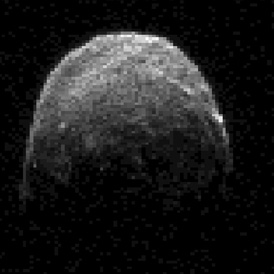Huge asteroid to pass by earth
An asteroid the size of an aircraft carrier will pass earth tonight, travelling closer than the moon. One astronomer tells Channel 4 News it will “give us clues about other bodies that are out there”.
The asteroid’s closest approach will be at 23.28 GMT, when the asteroid passes within 201,000 miles – or about eight-tenths of the moon’s distance – from earth.
It will be the closest the asteroid 2005 YU55 has been to earth in 200 years.
But scientists stress that it poses no danger. Instead, it will give scientists a rare chance to study an asteroid without the huge costs of launching a space probe.
The Goldstone Observatory in California and the Arecibo Observatory in Puerto Rico will track the asteroid on Tuesday, using telescopes with radio sensors to get a better idea of its physiological make-up.
Research scientist at the NASA jet propulsion laboratory, Lance Benner, told Channel 4 News that new technology is allowing scientists to view the asteroid in far more detail.
“The viewing resolution has increased from about 19 metres to 4 metres, so we’re seeing things like linear ridges and small impact craters on its surface. It’s around 400 metres in diameter and it’s very dark, comparable to a lump of charcoal,” Mr Benner said.
He said by studying the asteroid, scientists are learning more about how to plan in the event that an asteroid could collide with the earth in future.

“We’re learning a lot of things. But most importantly, we’re protecting the earth by improving our knowledge of orbits in the future.
“By studying this asteroid, we’ve found out that in 2075 there’ll be another close encounter with earth. But like this one, it won’t pose any risk.
“The aspect of how close it’s passing by is extraordinary.”
Mysteries of the outer belt
Astronomer at the QUB Astrophysics Research Centre, Alan Fitzsimmons, told Channel 4 News that the asteroid will help space scientists find out more about what can be found in the outer asteroid belt.
“It’s a particular type of asteroid that usually resides closer out towards Jupiter. And its surface is made up of rock that’s very rich in carbon, which we see sometimes in meteorites that fall to earth.
Objects like this give us an insight into conditions were like four billion years ago. It’ll also give us clues about other bodies that are out there. Alan Fitzsimmons, Astronomer at the QUB Astrophysics Research Centre
“That tells us that it’s from the outer asteroid belt, and because they’re usually so far from the sun they’re relatively unchanged from the start of the solar sytem 4 billion years ago.
“Objects like this give us an insight into conditions were like at that time. It’ll also give us clues about other bodies that are out there,” Mr Fitzsimmons said.
Planning for future collisions
It will also help scientists harness more information that could prove useful if an asteroid in the future was going to hit earth.
“Studying this asteroid will help to plan observation programmes in future. And help us to work out how much we still need to understand, and how much time needs to be devoted to it.
“It’s also very nice that mother nature is giving us a free fly-by of this particular asteroid, to save having to do a space misison to study one,” he added.
Mr Fitzsimmons told Channel 4 News that while it will not be visible to the naked eye, budding astronomers may be able to catch a glimpse of the asteroid using a large backyard telescope, provided it is not too cloudy.
Several other asteroids have passed by close to our planet, including the Apophis asteroid, which previously raised fears that it could hit earth in 2029 or 2036. Nasa says there is now only a one in 250,000 chance that the Apophis asteroid could make impact in 2036.